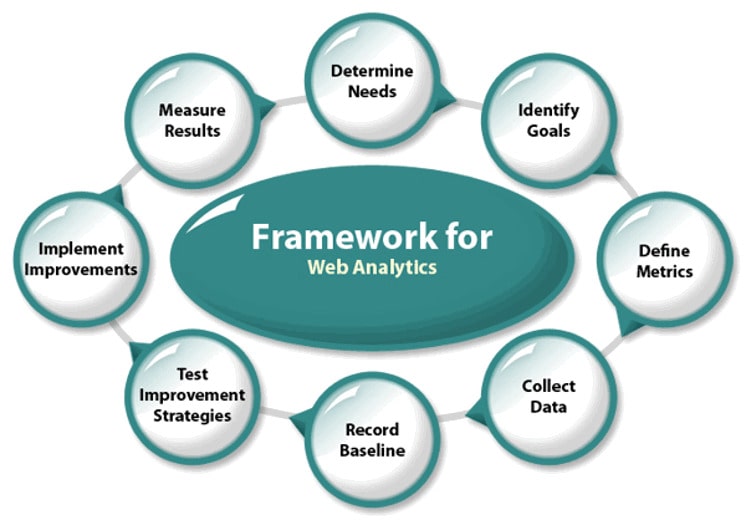Table of Contents
When you’re a business owner or marketer, devising an online marketing strategy can seem daunting given the myriad of options available. There’s a plethora of methods to promote your brand/service/product, and pinpointing the most effective one can be quite a task. Data suggests that the typical conversion rate for websites stands at 2.35%.
This implies that out of every 100 visitors to your site, whether through direct searches, social media, or other channels, merely 2 will become customers. Understanding and improving your user experience by monitoring your web analytics is a major factor for your business growth.
The Role of Web Analytics
To boost your conversion rate and subsequently your revenue, there are several factors to consider. Primarily, it’s essential to tailor your website content to resonate with user preferences. Gaining insights into your target demographic, their interaction patterns on your site, their origins, etc. can guide you in crafting content that appeals to them and refining the user interface and experience to minimize conversion barriers.
But what’s the key to achieving this? Enter website analytics! It’s a cornerstone of all online marketing endeavors. In essence, it’s about examining your website’s traffic to identify areas of improvement. Herein, we’ll delve into the primary reasons underscoring the value of website analytics in business expansion.
Decoding Web Analytics, Why Web Analytics Matters?
Your website offers a treasure trove of data regarding user interactions. This data encompasses aspects like referral sources, most frequented pages, total page visits, and much more. The process of monitoring this vast array of data is termed website analytics. For budding enterprises and small-scale businesses, navigating this sea of data can be overwhelming.
For digital marketers, the challenge lies in interpreting this data to keep a pulse on website performance. It’s crucial to differentiate between web analytics and website statistics. They’re not synonymous. While website statistics provide basic insights like monthly visitor counts, web analytics delves deeper, offering a richer set of metrics.
In a nutshell, web analytics for online business illuminates underlying patterns and sheds light on the ‘why’ behind specific site behaviors. Ultimately, web analytics is instrumental in refining your website and its associated online marketing strategies. It’s a tool to gauge and benchmark site performance, focusing on the key performance indicators (KPIs) pivotal to your business.
Why Should Businesses Prioritize Web Analytics?
Thriving startups and businesses are data-driven, meticulously tracking a multitude of metrics. Without this, discerning what’s effective and what’s not becomes a guessing game. Furthermore, without data, pinpointing inefficiencies in marketing efforts and areas of improvement becomes a challenge. Regrettably, many marketers rely heavily on intuition and ‘gut feelings’ for pivotal marketing decisions.
While instincts are valuable, they can’t contest the objectivity of hard data. Numbers are unbiased and straightforward. If you’re sidelining web analytics for online business, you’re essentially navigating in the dark. A comprehensive marketing report is pivotal in validating the efficacy of your marketing blueprint.
It offers a concrete, data-backed overview of your achievements and insights from past campaigns and initiatives. Pairing website analytics with reporting provides a precise measure of your marketing campaign’s effectiveness, ensuring future endeavors are spot-on.
The Mechanics of Web Analytics
To monitor user interactions, marketers employ analytics tools that track user clicks and page visits. These tools ‘tag’ web pages by embedding a JavaScript code snippet. This enables marketers to glean essential details like the user’s location, browser, and device, traced via their IP address.
Conversely, web analytics employs ‘cookies’ to monitor individual sessions and detect repeat visits from the same browser. However, there are limitations. Browser restrictions on code snippets and frequent cookie deletions by users can skew accuracy.

Different analytics tools might yield slightly varied results. Nonetheless, web analytics offers a comprehensive dataset to inform your subsequent marketing strategies. Here’s a snapshot of the 10 major areas web analytics can cover and provide information about them:
- Campaign Insights
- Keywords leading to site visits
- Top referral web pages
- Most effective campaigns
- User Behavior
- Most visited pages
- Demographic Data
- User location, age, profession
- Unique visitors and total visits
- Ratio of new vs. returning customers
Not All Metrics Hold Equal Weight
Given the vast amount of accessible data, discerning relevant from irrelevant metrics can be challenging. Marketers can track everything from social media engagement to website traffic. This capability to gather and interpret data enables you to pinpoint areas of improvement and those that are functioning optimally.
For web analytics to be truly effective, consistent measurement and tracking are essential. Remember, web analytics is most relevant for specific campaigns over a defined period. Relying on the same metrics over extended durations can render them obsolete.
Regularly updating your analytics report, be it quarterly or at other intervals, allows you to spot ongoing trends. This facilitates timely adjustments to your marketing strategies. It’s essential to differentiate between superficial metrics and those that truly matter.
Vanity metrics might inflate perceived success but offer little tangible value. In contrast, seasoned marketers align their metrics with ROI. If the metrics you’re evaluating don’t reflect revenue implications, they’re likely not serving your business’s best interests.
Examples of such vanity metrics
Email Open Rates
While it might seem that higher email open rates indicate success, they merely reflect the appeal of your email’s subject line.
View Count
Video marketing has surged in popularity recently. If your business has a YouTube presence or features videos on its site, view counts might seem crucial.
Blog Post Views
While high blog post views suggest quality content, they don’t reveal the source of these views or the reader’s engagement level.
Metrics Worthy of Your Attention
Given the plethora of metrics, it’s easy to get overwhelmed. Focus on those metrics that directly correlate with ROI.
Bounce Rate
A ‘bounce’ denotes a visitor leaving your site without returning. For instance, if a visitor captures a screenshot of your contact page and exits, it’s not necessarily a negative indicator.
Conversion Rate
While website traffic is vital, if a large volume of visitors doesn’t translate to conversions, it’s futile.
Selected Book on the matter
Avinash Kaushik’s book, “Web Analytics 2.0: The Art of Online Accountability and Science of Customer Centricity,” offers a thorough manual reshaping the approach businesses take towards web analytics. Kaushik traces the historical progression of web analytics, starting from its early stages to the advanced and user-focused methods of Web Analytics 2.0. He underscores the drawbacks of conventional analytics methods and paves the way for a transformative shift towards a model that prioritizes customer-centricity and accountability. This comprehensive guide challenges traditional approaches, advocating for a more dynamic and responsive methodology in the ever-evolving landscape of online analysis.
Final Thoughts
Web analytics for online business can
- Efficiently tracking e-commerce metrics for increased sales
- Identifying top outbound links for potential partnerships
- Strategizing and tracking top referrals for enhanced results
- Enhancing your website’s SEO
- Identifying top-performing content
- Understanding your audience for an improved user experience.





